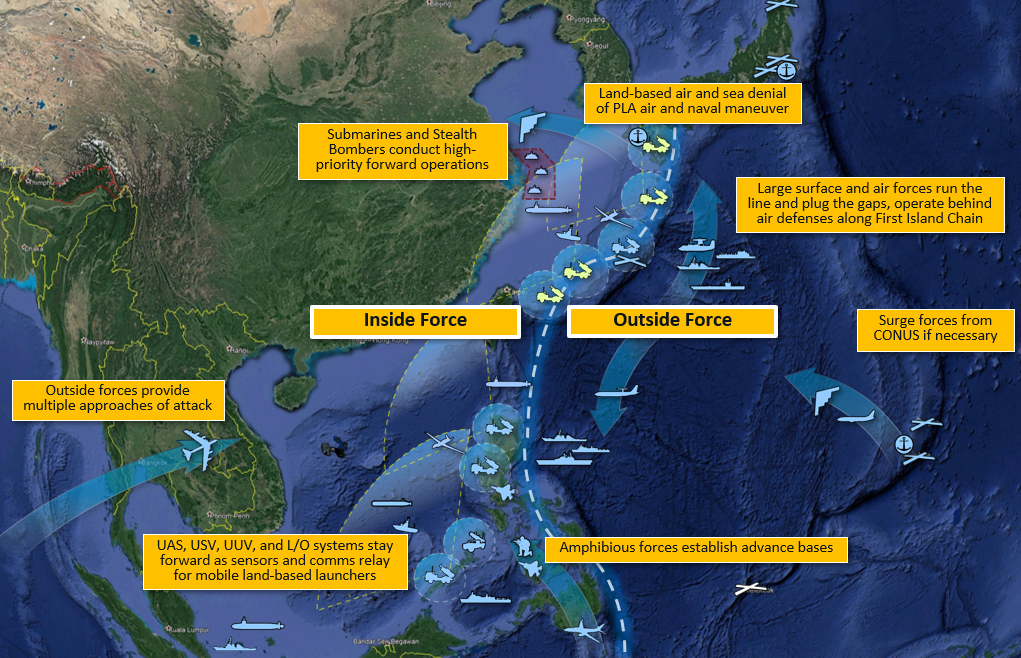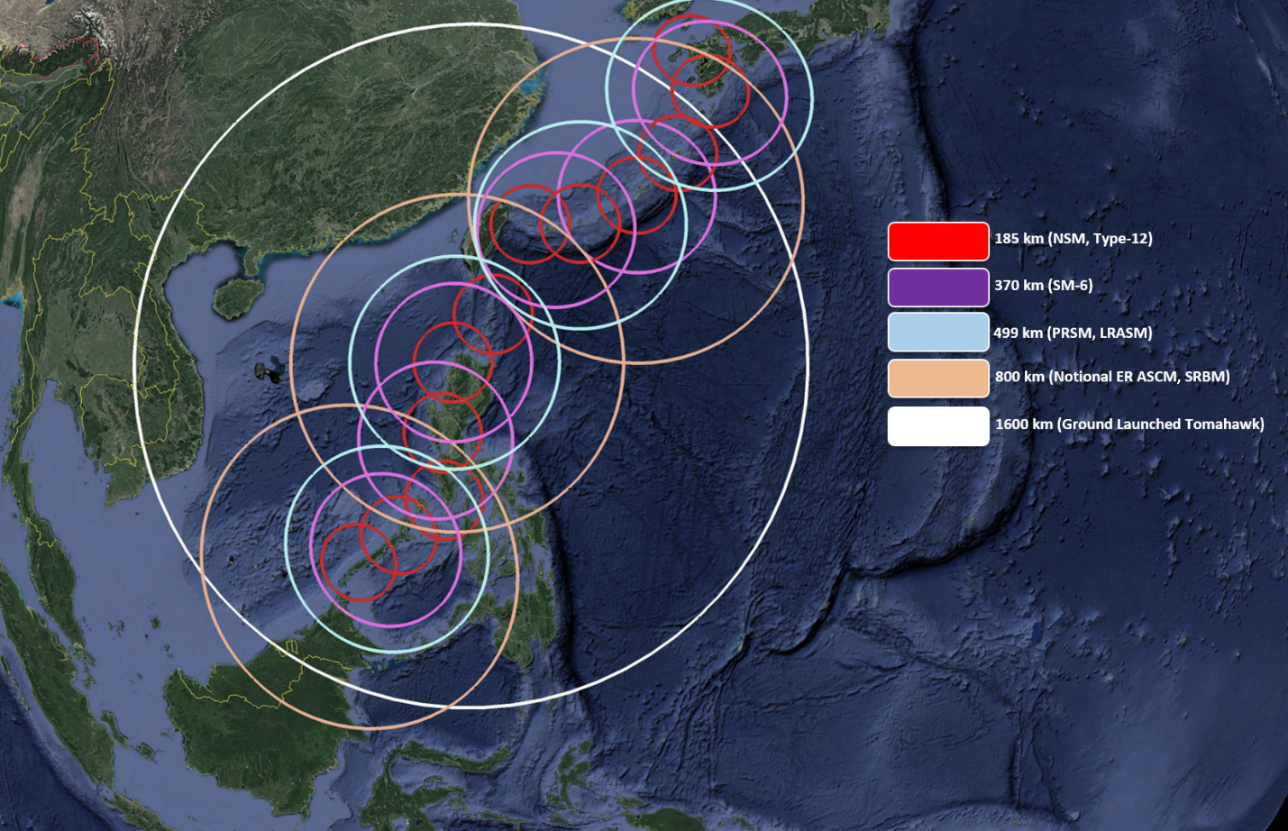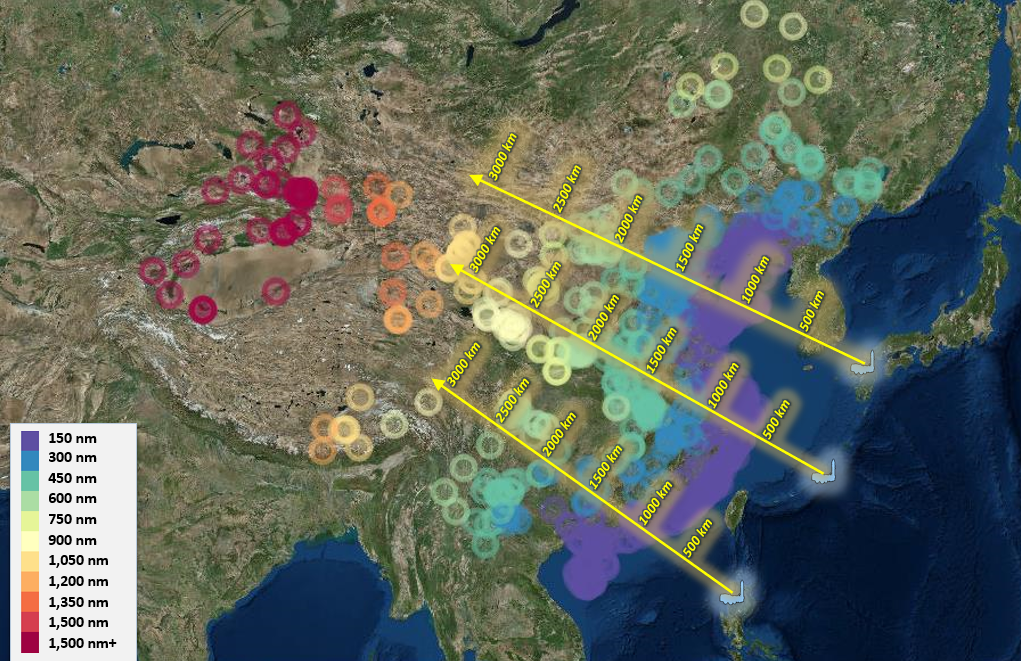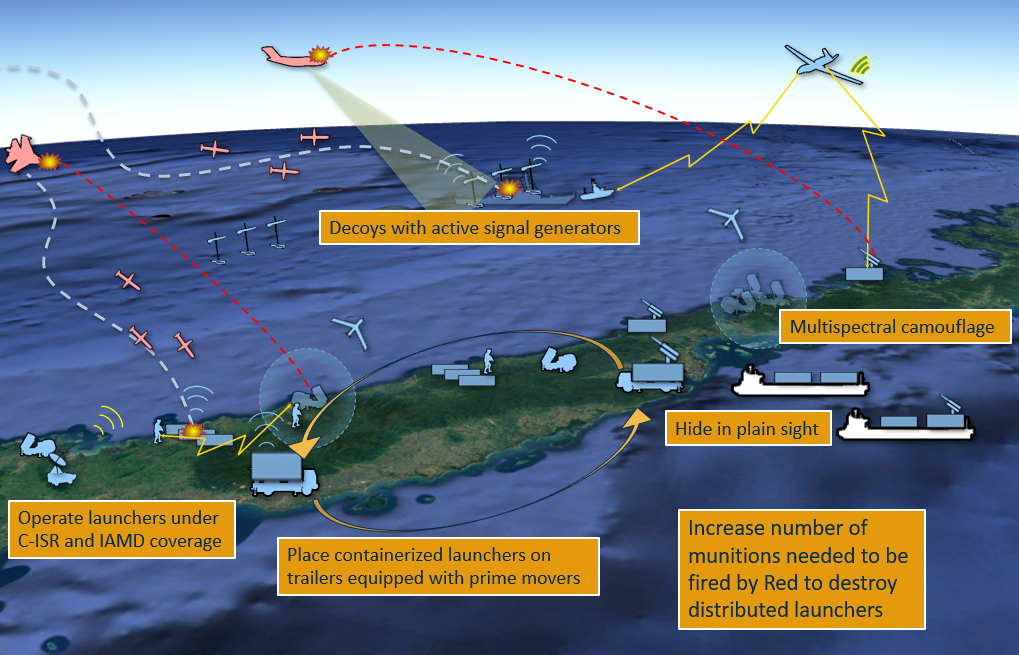The following is adapted from a recent report by the Center for Strategic and Budgetary Assessments, Tightening the Chain: Implementing a Strategy of Maritime Pressure in the Western Pacific.
By Peter Kouretsos
The U.S. military has a problem in the Western Pacific: the tyranny of distance and time. Delivering military force across the vast Pacific Ocean has never been easy, even for a country as blessed in resources and ingenuity as the United States. The problem has worsened as America’s chief regional rival, China, has improved its ability to harm American interests quickly and with limited forewarning. Seventy years after Mao Zedong proclaimed the People’s Republic of China, China’s military capabilities have matured to the point where, if directed by the Chinese Communist Party (CCP), the People’s Liberation Army (PLA) could launch a rapid attack to change the status quo, including territorial seizure, before the United States could meaningfully respond, thus presenting Washington with a fait accompli. American forces located outside the conflict area would have to penetrate China’s anti-access/area-denial (A2/AD) network to restore the status quo ex-ante, a daunting proposition. Under these circumstances, Washington might face the unenviable choice of doing nothing or escalating to higher levels of violence. Either way, the national interests of both the United States and its closest allies would suffer dramatically.
To address this challenge, a new CSBA report proposes a U.S. military strategy of Maritime Pressure and a supporting joint operational concept, “Inside-Out” Defense, to stabilize the military balance in the Western Pacific and deny China the prospect of a successful fait accompli. The report goes beyond previous studies by outlining a new operational concept, assessing potential Chinese responses, and estimating the budgetary costs of implementing it.
Strategy in Brief
The United States faces a geographic asymmetry in the Western Pacific. China’s primary territorial concerns—Taiwan, the South China Sea, and the East China Sea—are far closer to its mainland than they are to the United States. In contrast, the United States has territory, allies, and interests in the Western Pacific but must traverse the expanse of the Pacific Ocean to defend them. At the same time, the PLA has developed a counter-intervention doctrine and supporting A2/AD capabilities to stifle the U.S. military’s ability to project power rapidly into, or operate effectively within, the Western Pacific during a conflict. Given these challenges, the United States would be hard-pressed to overcome the tyranny of distance and Chinese A2/AD capabilities quickly enough to deny a Chinese fait accompli.
For example, in the direst scenario involving an all-out PLA attack on Taiwan, U.S. and allied military forces would have to respond in force quickly, within hours or days, to thwart a Chinese fait accompli attempt. U.S. and allied forces would not have weeks or months to concentrate in mass near the theater of operations and then counterattack before China seizes control of Taiwan or forces the Taiwanese government into submission. Nor would friendly forces have time to fight their way to decisive points in the battlespace if they begin the conflict outside China’s A2/AD bubble. Moreover, attempting to rollback Chinese gains and liberate Taiwan after the fact would be difficult, costly, and potentially escalatory.
American policymakers are right to worry about such a scenario. History shows that deterrence is more likely to fail when an aggressor believes it can pull off a fait accompli successfully. If Chinese leadership believes it can achieve gains through aggression quickly and without paying steep costs in blood, treasure, and reputation, it may be tempted to escalate a crisis to open conflict.
As a deterrence by denial strategy, Maritime Pressure aims to persuade Chinese leaders that attempting military aggression in the Western Pacific will fail, thus discouraging them from trying it. The strategy uses the geography of the First Island Chain—the barrier formed by Japan, Taiwan, the Philippines, and maritime and peninsular Southeast Asia—to deny Chinese military supremacy within, and constrain China’s access beyond, the Western Pacific during crisis or war. Specifically, it aims to thwart Chinese sea control, air superiority, and information dominance, conditions viewed by Chinese leaders as essential to military victory, in order to reduce the Chinese leadership’s confidence in its ability to control the course and outcome of a future conflict, thus bolstering deterrence. In short, by creating doubt in the minds of Chinese leaders about the prospects of a fait accompli gambit, Maritime Pressure discourages them from attempting it in the first place.
As a defense-oriented denial strategy, Maritime Pressure can complement or substitute for alternative approaches such as blockade operations or punishment strikes against mainland China. Those alternatives, although potentially useful as part of a broader campaign to prevail in a protracted conflict with China, would likely not achieve success rapidly enough to thwart a fait accompli, and could escalate the conflict beyond the risk tolerances of U.S. and allied political leaders. Without a strategy designed to prevent a fait accompli, the United States might lose a war before alternative approaches have time to be effective. At a minimum, Maritime Pressure could buy the United States and its allies time, creating the space for other approaches to take effect.
Inside-Out Defense as a Point of Departure Operational Concept
A strategy of Maritime Pressure requires a supporting operational concept that can balance the need to respond rapidly enough to offset the U.S. military’s time-distance challenge without having to physically concentrate U.S. forces on a small number of large, close-in bases that are highly vulnerable to China’s robust area denial capabilities. That is, the operational concept must allow the U.S. military to create the virtues of mass rapidly without the vulnerabilities of concentration.
Inside-Out Defense combines lethal and resilient “inside” forces able to fight and persist within highly contested environments with agile “outside” forces capable of fighting from standoff distances or penetrating A2/AD networks. Together, these inside and outside forces could create a responsive, yet survivable, forward defense-in-depth in the Western Pacific capable of rapidly blunting Chinese aggression at the outset of a conflict. To use a football analogy, the inside forces would act as a defensive line while the outside air and naval forces acted as linebackers. While China may control the snap count, the “Inside-Out Defense” concept will demonstrate that the U.S. is ready to play.

Inside forces: Below the level of armed conflict, inside forces forward postured in the Western Pacific would provide a persistent, combat credible signal of U.S. commitment, which should give Chinese leaders pause by complicating their decision calculus and undermining their confidence in their military plans. In the event of conflict, they would exploit the region’s maritime geography and assume a dispersed, resilient posture along the First Island Chain to form an initial defensive barrier that could immediately challenge Chinese military operations and play three key roles. First, they would contest what Chinese doctrine has identified as necessary prerequisites for conducting a successful military campaign: air superiority, sea control, and information dominance. Second, they would attack Chinese power projection forces to delay and deny their ability to achieve objectives through aggression, such as seizing the territory of U.S. allies or partners, while blocking China from projecting power beyond the First Island Chain. Third, they would degrade key Chinese systems to create gaps in China’s A2/AD networks that outside forces could then exploit.
Mobile and dispersed ground forces—and amphibious forces ashore—would form the backbone of these inside forces. Leveraging the inherent survivability of mobile, hard-to-find ground forces augmented with counter-detection aids, such as camouflage, concealment, and deception (CCD), the inside forces would transform the First Island Chain’s archipelagos into defensive bastions bristling with multi-domain capabilities such as sensors, missiles, and electronic warfare systems. Undersea platforms, both manned and unmanned, could operate within or near the East China Sea and South China Sea to augment these island bastions as part of the inside forces.
Outside forces: Primarily consisting of air and naval surface forces, outside forces would provide a flexible and agile element to support the units arrayed along the First Island Chain. The overwhelming mass of U.S. combat power would reside in these outside forces. In the event of conflict, they would back up the defensive barrier and provide defense-in-depth in the Second Island Chain. If necessary, they could surge forward to plug any gaps in the defensive barrier of inside forces created either by lack of U.S. access to allied or partner territory or through attrition from Chinese attacks. By employing standoff and penetrating capabilities, these outside forces could exploit gaps in the Chinese A2/AD complex created by the inside forces in order to augment defensive operations with additional mass and conduct offensive operations. Outside forces could also leverage their greater freedom of maneuver to conduct other priority missions, such as holding Chinese overseas assets at risk or interdicting Chinese maritime commerce.
Lines of Operation
Sea denial: From distributed positions along the First Island Chain, ground forces equipped with launchers capable of firing ASCMs or anti-ship ballistic missiles (ASBMs) could attack Chinese surface ships, creating gaps in China’s outer defenses that outside air and surface forces could then exploit. Undersea forces, including both manned and unmanned platforms, could augment inside ground forces by acting as forward sensors and conducting torpedo and ASCM strikes against Chinese ships, as well as provide the principal method of defeating Chinese undersea forces within the First Island Chain. Surface combatants, 4th generation fighters, and legacy bombers, operating over ground-based air defense bubbles along the First Island Chain, could also support sea denial operations with long-range ASCMs. Other stealthy platforms could operate forward to conduct maritime strikes and act as sensors for land-based missiles. Equipping distributed ground forces with a family of missiles with greater ranges than ones they currently possess (Figure 2) would hedge against more restrictive access for U.S. forces on allied and partner territory, enable ground forces to attack PLAN forces operating closer to China and in the Taiwan Strait, and provide more robust fields of overlapping anti-ship fires.

Air denial: Given the long operating distances from airbases primarily located in the Second Island Chain and beyond, U.S. and coalition forces would not be able to continuously contest air superiority in the conflict area. An improved land-based integrated air and missile defense (IAMD) architecture positioned along the archipelagoes of the First Island Chain could help pick up the slack. It would consist of a layered defense of mobile, long-range, wide-area, and short-range point air defense systems employing a mix of missiles, guns, and directed energy capabilities such as lasers and high-power microwaves. Additionally, ISR platforms and fighters partially sheltered behind land-based integrated air defense systems on the First Island Chain could enhance battlespace awareness and plug limited gaps in the air defense perimeter. Penetrating manned and unmanned fighters could also conduct periodic sweeps to contest Chinese air operations.
Information denial: The PLA views information dominance as the most critical condition necessary for victory. As such, counter-C4ISR and information denial operations could have outsized effects in deterring and, if necessary, defeating Chinese aggression. Information denial operations would focus on complicating Chinese ISR, increasing demands for persistent targeting, disrupting communications networks, and ultimately paralyzing China’s centralized decision making. Both inside and outside forces could employ a variety of land-attack, anti-ship, and anti-air weapons to strike Chinese sensors and key nodes to degrade its C4ISR networks. Forces employing electronic warfare, counter-space, and cyber capabilities, augmented by CCD and tactical mobility, could confuse remaining sensors, degrade communications, and overwhelm Chinese information processing and decision-making.
Land attack: Land attack operations would degrade Chinese land-based A2/AD systems—including command and control nodes, sensors, long-range missile launchers, aircraft on the ground, and SAM systems—to create gaps that outside forces could exploit. As with sea denial operations, land-based strikes could be augmented by land-attack cruise missile strikes delivered by submarines, outside air and naval forces conducting standoff attacks with long-range missiles, and stealth aircraft staging attacks from closer in. Now unconstrained by the INF Treaty, the U.S. could regain land-based long-range strike capabilities, forcing China to devote more resources to air and missile defenses. Although not always cost-effective for delivering large salvos, they have considerable value in promptly striking time-sensitive targets such as aircraft on the ground, missile launchers, massed formations, capital ships in port, and critical C4ISR nodes.

Preserving C4ISR: Attacking China’s C4ISR architecture alone would be insufficient to gain and maintain allied information advantage in a Western Pacific contingency. The U.S. military would also need to preserve friendly C4ISR in the face of Chinese counter-C4ISR capabilities. The U.S. military should thus seek to improve the resiliency of its C4ISR architecture to mitigate the impact of Chinese attacks. But given China’s vast and sophisticated counter-C4ISR capabilities, the U.S. military likely could not prevent disruption or even temporary denial of its networks. Therefore, the U.S. military must be careful not to build an overly centralized theater battle network that must be protected from any significant degradation to function. Rather, the U.S. military should accept that highly contested and degraded information environments will be the norm in future warfare. As such, the U.S. military should develop a C4ISR architecture built for sub-optimal conditions that leverages the inherent strength of the joint force to overcome adversity. In short, the U.S. military should confront China’s highly centralized system designed to operate under the optimal conditions of information dominance with a more resilient U.S. C4ISR system able to continue fighting despite the chaos of the modern battlefield.
Defending forces and bases: Since U.S. forces cannot perfectly hide or defend against China’s planned precision strikes, they must withstand the initial salvo. Hardening key nodes such as communications hubs, fuel stores, and aircraft shelters would help improve resiliency and increase the number of Chinese munitions required to suppress targets. Dispersal of ground and air forces to numerous locations along the First and Second Island Chains would minimize the loss of any large single location. Properly networked, these positions would be mutually reinforcing. Adopting an air defense concept focused on short-and medium-range (10–30 nm) engagements could give defenders greater capacity at less cost. Mobile, distributed launchers such as HIMARS and trailer-mounted containerized launchers would practice disaggregation, tactical mobility, and CCD while operating under IAMD to degrade enemy targeting.

Sustaining forces: Inside-Out Defense would require sustaining highly geographically distributed forces operating in austere environments, all while under attack. Ground forces arrayed along the archipelagos of the First Island Chain would leverage pre-positioned stocks of munitions and supplies. Later, combinations of small air and sea assets could work together to resupply and add mobility to these small, dispersed formations. For example, in the near term, offshore support vessels could provide logistical support. In the future, extra-large UUVs—with a payload capacity of 2,000 cubic feet—could transport roughly eight tons of cargo to units operating near the coastline.3 Unmanned surface vessels and dracones could provide additional attritable cargo transport and refueling capabilities. From the air, rotary wing and tactical transport aircraft could operate from austere airfields and sea bases to transport cargo and assist with moving troops.
Recommendations and Costs
Having outlined the Inside-Out Defense concept, CSBA also assessed the current activities of U.S. and allied forces to illuminate where changes are needed most urgently. The report divided the assessment and recommendations into concepts, capabilities, and coordination to reflect Maritime Pressure’s emphasis on the United States pursuing countermoves in the areas of doctrine, technology, and allies, respectively.4 The report estimates that these actions would cost from $8 billion to $13 billion by 2024 depending on the specific investments selected by DoD. Although significant, such costs are affordable—especially if DoD spends less on legacy forces unsuited to contested environments and spends more on the innovative concepts and capabilities proposed in the report.
Concepts
Develop this report’s approach into a joint operational concept to support a strategy of Maritime Pressure in the Western Pacific. Over the last several years, the Army, Navy, Marine Corps, and Air Force have developed new warfighting concepts that fit comfortably within a strategy of Maritime Pressure. While the Army’s Multi-Domain Operations, Navy’s Distributed Maritime Operations and Marine Corps’ Marine Corps Operating Concept, and the Air Force’s Multi-Domain Command and Control each break some new ground, the services still devote too much attention to preserving the traditional American approach to power projection in the Western Pacific. Furthermore, service concept development efforts are relatively disjointed and uncoordinated from one another, and joint operational concept development is currently lacking within DoD.
Experiment with new organizational structures for ground forces in the Pacific. Given that it is forward stationed in the Western Pacific, III MEF and its subordinate units could form the core of the inside forces in an Inside-Out Defense concept. III MEF would also likely need to be augmented as inside forces with U.S. Army units located in the Pacific Theater such as the 25th Infantry Division. However, both formations are maneuver warfare-centric organizations best suited for traditional amphibious or ground combat operations. The Marine Corps and Army should experiment with alternative force designs that take advantage of novel combinations of C2, fires, air defense, security, ISR, engineering, electronic warfare, and sustainment capabilities to permit distributed, multi-domain fires in highly contested environments along the First Island Chain.
Develop sustainment concepts to support a Maritime Pressure strategy. Supporting distributed operations along the First Island Chain requires new concepts for sustaining operations across great distances while under attack. Planners should explore innovative approaches to support distributed units, including greater use of pre-positioned stocks of munitions and sustainment materiel, manned and unmanned air and sea assets for mobility and resupply, and emerging technologies such as 3D printing to fabricate replacement parts.
Capabilities
Accelerate fielding of mobile, land-based, long-range missile capabilities. Ground force contributions to sea denial, air denial, and land attack operations along the First Island Chain require sharper and longer teeth. Current efforts of the Army and Marine Corps to develop and field longer-range, land-based anti-ship and land-attack fires should be accelerated and should incorporate weapons with ranges in excess of 500 km. The Army and Marine Corps should also develop more mobile and longer-range land-based air defense systems to provide wide-area air denial along the First Island Chain with sufficient survivability for inside forces to fight and persist within China’s A2/AD network.
Build a resilient multi-domain C4ISR architecture and develop and field counter-C4ISR capabilities. In a future conflict in the Western Pacific, the battle for information advantage would likely be critical and could potentially prove decisive. The U.S. military should undertake efforts to make its C4ISR architecture more resilient while developing and fielding active and passive counter-C4ISR capabilities such as jammers and CCD.
Integrate all bomber aircraft with payloads for offensive maritime missions. DoD should integrate anti-ship missiles into its entire fleet of bombers. Although anti-surface warfare would be a new mission for these platforms, it would be a return to a role the bomber community played during World War II and the Cold War. These capabilities are currently being fielded with several aircraft such as the B-1B, but integrating them with all platforms possessing comparable ranges would give the United States a more robust capability to attack enemy surface combatants and other high-value maritime targets in highly contested environments at range.
Coordination
Deepen cooperation with Indo-Pacific allies and partners. Allies and partners will be critical in a Maritime Pressure strategy, both in terms of accessing their territory and the capabilities and forces they contribute. The U.S. military should engage closely with Indo-Pacific allies and partners to form enhanced access agreements for both peacetime and war, as well as gain a better understanding of what roles each ally and partner may be willing to perform and with what forces in each potential contingency. The U.S. military should also work to deepen interoperability and developed combined concepts of operations among U.S. and allied and partner forces, particularly with Japan and Australia.
Reexamine Service roles and missions. As new concepts for warfighting in the Western Pacific continue to mature, so too should existing Service roles and missions. For example, Inside-Out Defense envisions both Army and Marine forces playing a larger role in anti-surface warfare missions. But key questions remain, such as whether they would provide similar or distinct capabilities for those missions and whether they would perform the missions in separate or overlapping geographic areas. Answering questions like these will help harmonize ongoing efforts to develop new concepts and capabilities across the services.
Consequences
Attempting to overcome these American A2/AD investments will likely push China toward prioritizing short-range counter-A2/AD improvements over long-range power projection investments. Such an outcome would appeal to the United States and its allies since it would keep China ensnared in its maritime backyard within the First Island Chain. Alternatively, China might view popping the American A2/AD bubble as too risky and expensive and, as a result, shift attention and resources away from its eastern maritime frontier to its western land frontier. President Xi Jinping has increased Chinese involvement in continental Asia through his Belt and Road Initiative, so Maritime Pressure might reinforce an existing preference within the Chinese government for westward expansion. On the negative side, Maritime Pressure might encourage China to escalate horizontally by shifting the competition to other domains, including the economic or diplomatic spheres. Despite this risk, a Maritime Pressure strategy represents a feasible, affordable, and sophisticated approach for responding to China’s rise in the years ahead.
Peter Kouretsos is an Analyst at the Center for Strategic and Budgetary Assessments. He is the co-author, with Thomas G. Mahnken, Travis Sharp, and Billy Fabian, of Tightening the Chain: Implementing a Strategy of Maritime Pressure in the Western Pacific.
References
1. Ranges and their proxies in parentheses serve as examples, not as specific recommendations. With additional cooperation from partner governments, similar systems could also be placed elsewhere (e.g., Vietnam and Indonesia). NSM, Type-12, and SM-6 ranges are from IHS Jane’s. PrSM range is from Jen Judson, “U.S. Army to Prioritize Long-Range Missile Capability to Go After Maritime Targets,” Defense News, March 26, 2019, available at https://www.defensenews.com/digital-show-dailies/global-force-symposium/2019/03/26/army-to-prioritize-long-range-missile-capability-to-go-after-maritime-targets/. LRASM range is from Oriana Pawlyk, “Live LRASM Test from F/A-18 Super Hornet Expected This Year,” DoDBuzz, April 10, 2018, available at https://www.military.com/dodbuzz/2018/04/10/live-lrasm-test-f-18-super-hornet-expected-year.html. Tomahawk range is from “Tomahawk Cruise Missile,” U.S. Navy factsheet, April 26, 2018, available at www.navy.mil/navydata/fact_display.asp?cid=2200&tid=1300&ct=2.
2. Past CSBA wargames used a notional target set depicting the depth and concentration of Chinese military facilities, mobile weapons systems, airbases, and other sites of military value. Approximately 70 percent of the target set’s 50,000 aimpoints are located within 250 nm of the coastline of mainland China. The deepest aimpoints (red circles) indicate locations of known or suspected space installations, anti-satellite weapons sites, and other high-value targets.
3. The United States only intercepts 25 percent of the homemade submarines carrying narcotics across the Caribbean into the United States from Colombia. Logisticians should incorporate lessons gleaned from these smuggling operations into future sustainment concepts for heavily monitored and contested environments. Joe Gould and David B. Larter, “In America’s Opioid Crisis, Military Lets Drug Shipments Go By,” Defense News, February 15, 2018, available at https://www.defensenews.com/congress/2018/02/16/in-americas-opioid-crisis-military-lets-drug-shipments-go-by/
4. The current activities assessment is limited primarily to the missiles and sensors the authors recommend fielding in precision-strike networks along the First Island Chain. The authors acknowledge that the networks would contain many capabilities besides missiles and sensors. They also recognize that prevailing against China will require more than precision-strike networks. Previous CSBA research has explored other necessary capabilities in detail; interested readers should consult those studies for more information. For the present section, however, the authors have chosen to focus on the strike forces forming the backbone of a Maritime Pressure strategy.
Featured Image: A Japan Ground Self-Defense Force Type 12 Surface to Ship Missile System display its range of movement as part of the Orient Shield 2019 media day, Sept. 17 2019, Oyanohara Training Area, Japan. (U.S. Army Photo by Staff Sgt. Jacob Kohrs, 20th PAD)

